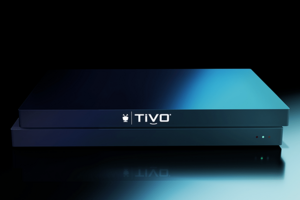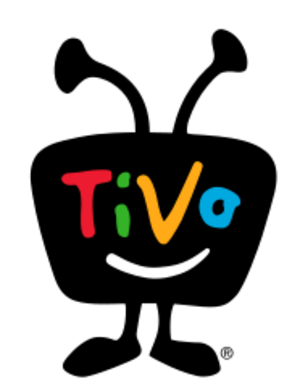TiVo facts for kids
 |
|

TiVo EDGE DVR
|
|
| Developer | Xperi |
|---|---|
| Type | Digital video recorder |
| Release date | March 31, 1999 |
| Operating system | Linux |
TiVo (pronounced TEE-voh) is a special device called a digital video recorder (DVR). It was created by Xperi and first came out in 1999. Think of it like a smart VCR for your TV! TiVo helps you find and record your favorite TV shows. It has cool features like "OnePass," which records every new episode of a series. There's also "WishList" to help you find shows based on actors, directors, or even keywords you like.
When your TiVo is connected to your home internet, it can do even more. You can download movies and TV shows, search for content online, and even schedule recordings from a website. TiVo was first launched in the United States. Over time, it became available in many other countries, including Australia, Canada, and the United Kingdom.
Contents
How TiVo Started
TiVo was created by two people, Jim Barton and Mike Ramsay. Their company was first called "Teleworld" but later changed to TiVo Inc.. They first wanted to make a home network device. But they changed their idea to a device that records TV shows onto a computer hard drive.
They showed their new device at a big electronics show in January 1997. Mike Ramsay then told his team that the first TiVo DVR would be ready by March 31, 1999. This was a very tight deadline! Because March 31, 1999, was a "blue moon" day, the engineers called this first TiVo "Blue Moon."
The first TiVo DVR could record TV from any source, like an antenna or cable. Later, TiVo also worked with satellite and cable companies. For example, in 2000, Philips Electronics made the "DirecTiVo." This device could record digital signals directly from DirecTV onto a hard disk.
TiVo also expanded to other countries. In 2000, it teamed up with Thomson Multimedia and British Sky Broadcasting to bring TiVo to the UK. TiVo also launched in Australia in 2008 and New Zealand in 2009.
In 2016, a company called Rovi bought TiVo. Then, in 2019, TiVo announced it would merge with Xperi Corporation. This merger was completed in May 2020. In early 2024, TiVo stopped selling the antenna version of its TiVo Edge DVR. However, the cable version and other TiVo devices are still available.
What a TiVo DVR Does
A TiVo DVR is like a super-smart videocassette recorder (VCR). Both let you record TV shows to watch later, which is called time shifting. But a VCR uses old-fashioned tapes. A TiVo DVR saves TV shows onto an internal hard drive, just like a computer.
TiVo DVRs can also guess what shows you might like and record them automatically. TiVo has a special feature called "trick play." This lets you pause live TV! You can also rewind and replay up to 30 minutes of what you just watched. TiVo DVRs can connect to your home internet. This allows them to download information, access streaming services like Netflix or Hulu, and even play music.
Cool Features of TiVo
TiVo DVRs regularly connect to TiVo's servers. This helps them get updated TV show information. This includes descriptions, actors, directors, and if a show is new or a repeat.
You can choose to record single shows. Or you can set up a "OnePass" (which used to be called "Season Pass"). A OnePass records all episodes of a show. You can even choose to record only new episodes or all episodes, including repeats. OnePasses can also "bookmark" shows from streaming services. This lets you see your recordings and streaming shows all in one place.
If you try to record too many shows at once, TiVo will prioritize them. It will record the most important shows first. TiVo DVRs with multiple tuners can record several shows at the same time.
TiVo used to have a feature called "TiVo Suggestions." This feature would record shows based on what you liked to watch. You could give shows "thumbs up" or "thumbs down." TiVo would then recommend other shows that people with similar tastes enjoyed. However, this feature is no longer supported as of 2023.
The amount of TV you can record depends on the size of the hard drive inside your TiVo. When the hard drive gets full, TiVo automatically deletes the oldest shows. But it will keep any shows you've marked to save. You can also add an external hard drive to your TiVo. This gives you even more space to record shows!
When you're not recording a specific show, TiVo records the channel you're watching for up to 30 minutes. This is super handy! If you miss something, you can rewind and watch it again. You can also pause live TV. Unlike VCRs, TiVo can record and play at the same time. You can start watching a show from the beginning even if it's still recording. Many people use this to skip commercials by waiting a few minutes before starting a recorded show.
TiVo DVRs connect easily to home networks. This lets you schedule recordings from TiVo's website. You can also transfer recordings between different TiVo units in your home. This is called Multi-Room Viewing (MRV). In the past, you could also transfer recordings to your computer.
TiVo used to offer many other online features, though most are no longer available. These included connecting with services like Amazon Video and Netflix. You could also view digital photos, listen to music, and get weather updates.
Paying for TiVo Service
To get all the cool features like TV schedules and software updates, you usually need a monthly subscription in the United States. However, in Australia, TiVo was sold for a one-time fee without extra monthly costs.
There are different types of "Product Lifetime Service." This means you pay once, and the service lasts for the life of that specific TiVo device. So, if you sell your TiVo, the lifetime service goes with it. TiVo devices can be used without a service plan, but then they act more like a basic VCR. They can only do manual recordings and won't get program guide data or updates.
Where TiVo Was Available
The TiVo service is currently available in the United States, United Kingdom, Canada, Mexico, Spain, and Taiwan. Over the years, people also found ways to make older TiVo models work in other countries like New Zealand and South Africa.
In Australia, the TiVo service ended on October 31, 2017. This meant that TiVo machines there could no longer get program guides or record shows.
TiVo in the UK
TiVo first launched in the United Kingdom in 2000. However, it didn't sell many units. Another company, BSkyB, launched its own DVR called Sky+, which became very popular. TiVo stopped selling new units in the UK in 2003.
But TiVo came back to the UK in 2010! This time, it partnered with a cable TV company called Virgin Media. Virgin Media started offering TiVo-powered set-top boxes. By 2015, Virgin Media had 2 million TiVo customers.
Inside a TiVo DVR
TiVo DVRs are designed by TiVo Inc. They use special software based on Linux, which is a type of computer operating system. Different companies have made TiVo units over the years, including Philips, Sony, and Humax.
TiVo DVRs have computer parts inside, like processors and large hard drives. These hard drives store all your recorded TV shows. Some newer TiVo models can even connect to an external hard drive to add more recording space. These external drives plug into the TiVo using a special cable.
Some TiVo models made by Toshiba and Pioneer even had DVD-R/RW drives. This allowed you to burn your recorded shows onto a DVD disc.
All standalone TiVo DVRs have inputs to connect to your TV signal, whether it's from an antenna or a cable box. They also have outputs to connect to your television. Early TiVo models could only record one channel at a time. But in 2006, TiVo introduced models with two tuners, allowing you to record two shows at once.
Some TiVo systems were built into DirecTV receivers. These "DirecTiVo" recorders could save the digital satellite signal directly to the hard drive. This meant the recorded video had the same high quality as live TV. These units could also record two shows at once. However, DirecTV later stopped selling TiVo-powered recorders.
Since 2005, all new TiVo units have been able to record HDTV (High-Definition Television). This means they can record shows in super clear quality from an antenna or cable.
Adding More Storage
TiVo worked with Western Digital to create external hard drives specifically for TiVo HD and Series3 systems. These drives connect to the TiVo using an eSATA port. The first version was 500 GB, and later a 1 TB (terabyte) version came out. A 1 TB drive can add up to 140 hours of HD recording!
It's important to know that once you add an external drive, you shouldn't disconnect it. This is because TiVo spreads the recording data across both the internal and external drives. If you disconnect the external drive, you might lose access to recordings made after it was added.
Customizing Your TiVo
Some users have found ways to customize their TiVo boxes. They might install bigger hard drives to record more shows. Others have created special software to transfer videos between TiVo boxes or to their computers. These customizations are not officially supported by TiVo and might affect your warranty.
TiVo saves recorded shows as special ".TiVo" files. These files are protected with a "Media Access Key" (MAK). But some clever software developers have created programs that can remove this key. This allows users to watch or share their recordings more easily.
TiVo in the Cloud
In 2018, TiVo announced a new platform for TV providers like cable companies. This platform lets providers use TiVo's user interface, voice control, and recommendations on many different devices. This includes traditional DVRs, streaming devices like Apple TV, and even phones and tablets. TiVo hopes this will help them compete with streaming services like Netflix and Hulu.
In the 2020s, some internet companies like TDS and Astound started using TiVo's user interface for their TV and cloud DVR services. These devices can also run apps for popular streaming services.
TiVo's Place in the Market
TiVo was one of the first DVRs. Another early competitor in the United States was called ReplayTV. ReplayTV had a feature that could automatically skip commercials. TiVo decided not to add this feature, worrying it might upset the TV industry. ReplayTV was actually sued over its commercial-skip feature, which contributed to its owner going out of business.
Other companies, like Dish Network (now Dish), also created their own DVRs around the same time. Over the years, many cable and satellite companies started offering their own DVRs. For example, Comcast and Verizon offer DVRs made by companies like Motorola.
Even though many companies offer DVRs, TiVo has continued to have subscribers. As of January 2016, TiVo reported having 6.8 million subscribers.
See also
- TiVo digital video recorders




